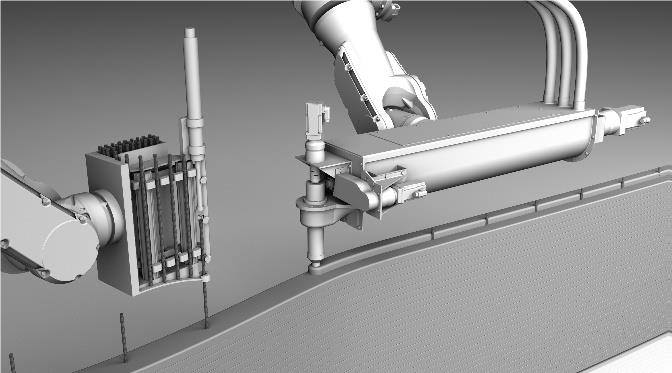Research Summary Report of A03
Extrusion of Near-Nozzle Mixed Concrete – Individually Graded in Density and in Rate of 3D Fibre Reinforcement
[06.08.2023]
M.Sc. Dahlenburg, Maximilian; TP editor, maximilian.dahleburg@tum.de, TUM, Chair of Materials Handling, Material Flow, Logistics
Prof. Dr.-Ing. Fottner, Johannes; Project leader, j.fottner@tum.de, TUM, Chair of Materials Handling, Material Flow, Logistics
Main Goal
The main goal of A03 is to establish a novel concrete extrusion process using a near nozzle mixing (NNM) process to enable the change and non-discrete gradation of material and its properties during printing. With this approach, multi-functional and multi-material parts can be printed, with an overall higher building rate due to a lower workability demand of the process and higher structuration rates of the used materials. Printed parts can thus simultaneously fulfil load-bearing and thermal insulation functions by locally changing the material properties. Thus, the sustainability of the printed parts can be improved through their intended use of material.
Gradation-ready-Extrusion-System (GRES) eliminates long pumping distances known from “conventional” extrusion systems, hence reducing the need for temporary flowability. By switching between different aggregates and with the precise dosing process of liquid phases GRES allows a robust change of material properties. Combining GRES with other AM processes elevates the potential of AM. This will be shown by producing a collaborative demonstrator together with C03 incorporating functions and C04 automating path generating according to the outside and inside wall geometry.
Current state of research
A collaborative demonstrator called “Marriage of Two Materials” was built by the combined efforts of A03, C03, C04, and architecture students (see Fig. 2). C03’s functional integration of recast rebars, water gauges and -lines, electrical lines, and ventilation highlights the advantages of Additive Manufacturing (AM) in construction. Furthermore, the adaptive path planning of C04 demonstrates the flexibility of Extrusion 3D Concrete Printing (E3DCP) in terms of path planning for special site conditions.
The demonstrator, comprising 57 layers and exceeding 1 km in path length, posed a substantial operational challenge. The initial strategy was to utilize the following gradation strategy: the inner wall sections were intended to be constructed using a natural sand-based mortar, optimizing for structural strength, while the outer wall sections were designated for a lightweight mortar to augment insulation capabilities. The gradation process required an alteration of materials during printing, a task both theoretically and practically feasible. However, it demanded that the operators manually transition the materials twice per layer. Given that this task would need to be performed around every 2 minutes throughout the printing process, it was deemed ergonomically unsustainable. Consequently, gradation layers were incorporated into the bottom print section and the final layer to demonstrate the feasibility of gradation with GRES.
The “Challenge of large-scale” was, in this instance, effectively refuted, transforming into a “Benefit of large-scale”. The relatively ‘compact’ size of the printed element resulted in reduced layer times. By comparison, larger printed elements – such as entire houses – would necessitate longer layer times, thereby providing extended periods for material transitions. As a part of future prototype development, an automated system involving two independent hoppers is projected to alleviate the requirement for manual material switches.
We are currently working on identifying optimization potentials by conducting parameter studies to improve GRES V1.3 to a more automated, robust, and lighter system for research and industry transfer in the future.











